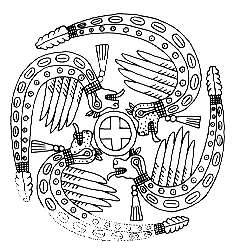|
Click Here for More Info on Seminole Indian Patchwork
Please click on the Seminole Indian Patchwork link above to see the examples that are talked about in this article,
and to see other designs and info on this beautiful cultural legacy.
There are more links at the bottom of this article to click on to learn about other syles of dress and dance
clothing styles. Scroll to the bottom of this article to click on other links.
Seminole Patchwork
by
Eglclan

Photo courtesy of the Seminole Tribe of Florida
The beautiful patchwork still being produced today originated from very humble beginnings. Some patchwork
pieces date back to the 1830s when the Seminoles sought refuge in Florida's Everglades.
Cotton fabric was obtained
through trade which usually happened only once per year. Early patchwork began out of necessity. Since trade was so infrequent,
the women began to piece together small strips of cloth from remnants of fabric. When these strips were hand-sewn, Seminole
patchwork was born!
Due to the amount of hand sewing required, most clothing articles had only one strip of patchwork.
In the 1900's, hand crank sewing machines became available setting off an explosion of Seminole patchwork. Machines made it
possible to finish several strips of work in less time than sewing only one by hand.
Garments were adorned with patchwork
that sometimes reflected the wearer's clan. Then,as in now, many garments were made for the growing tourist industry.
Explaining
the patchwork process is not enough, especially for those of you (like myself), who need a good visual. Many thanks to Nea
Dodson who provided these instructions and diagrams. (neadods@aol.com )
Seminole patchwork is very complex geometric
designs made from fabric strips which are sewn together, cut apart, and sewn back together in new formations. The most basic
design is a quick way of making blocks on point. For the scrap quilter, it is a good way of making a border of scrap blocks
set off by a neutral fabric.
1. Cut your scraps into equal sized squares. Accuracy is key in Seminole patchwork.
2. Next, cut a neutral fabric into long strips, which are as wide as the scrap squares.
3. Sew the
scrap squares between two strips of neutral fabric, like this:

4. Cut the strips apart so you have a rectangle made of three
squares: a square of neutral, a scrap square, and another square of neutral. It is important that the edges be straight and
the two neutral sides are even.
5. Shift one rectangle down so that the top edge of the uppermost neutral square
on the right is even with the top edge of the scrap square on the left. Sew the rectangles together. Keep adding rectangles
in this manner. You will get a strip that looks like this:

Keep adding rectangles until you have a strip as long as you want. Turn the strip so that the
scrap squares are all on point (standing on one corner). Trim the upper and lower corners off the neutral squares (see the
dotted line in the previous picture).
You now have a strip that looks like this.

Here is an animation of how strips are put together. http://www2.austin.cc.tx.us/hannigan/Presentations/NSFMar1398/hannimate.html
This excellent website shows the patterns and stories that
go with them.
The Mathematics of Seminole Patchwork
Link to the Seminole Tribe of Florida website.
Seminole Tribe of Florida: Culture: Seminole Clothing: Colorful Patchwork
|
 |
|

